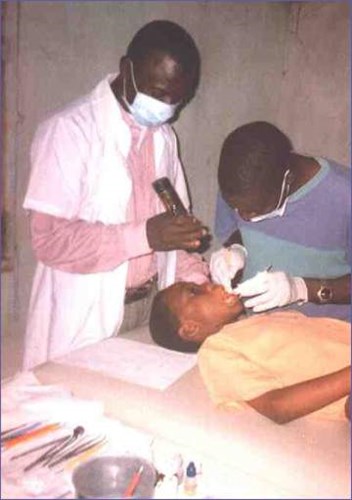South Africa - An Atraumatic Restorative Treatment (ART) Project: Activity Report
South Africa - An Atraumatic Restorative Treatment (ART) Project: Activity Report
Introduction
The Division of Community Dentistry, University of the Witwatersrand, South Africa, in the year 2000 implemented a training, research and service programme in the Atraumatic Restorative Treatment (ART) approach. This presentation is based on the study by Mickenautch S. and Rudolph M.J., published in 2001. We thank Dr S. Mickenautch for providing the illustrations for this presentation.
Background and Rationale
The South African population, especially the children, shows high prevalence of untreated dental caries. This is due to dental service inaccessibility and non-availability or non-utilisation of available services. As caries progresses it often leads to extraction or expensive and complex treatment.
The ART approach was adopted in public dental health services in South Africa as an appropriate and economic means of providing basic restorative care in communities where it was not possible before. ART also offers a less traumatic treatment concept for fearful patients and children in the private dental practice.
ART consists of the removal of caries using hand instruments only. The excavated cavity is then restored permanently with a fluoride releasing material. ART has the advantage of low cost equipment, no electric dental drills needed and is a simplified and appropriate intervention in dental outreach programmes.
Project Outline
Aim of this programme is the promotion of ART at various levels within the oral health care system in South Africa.
- public health services in selected provinces
- private oral health care sector
- oral health training institutions
- governmental and/or non-governmental oral health care services for refugee communities.
Achievements
In 2000, the University of Witwatersrand implemented a training, research and service programme in the ART approach.
Training:
- Sixty nine operators were trained during 11 ART courses between March and October 2000.
- Following the training 24 dentists and 18 dental therapists in public services and 31 private dentists in seven provinces now implement ART.
- Although 12 oral hygienists attended the ART courses they have not utilised this technique, due to current regulations in the country.

Community Services:
ART, together with tooth extractions, scaling and medication were performed in two disadvantaged communities Zonkizizwe and Orange Farm (Gauteng). Oral health services consisted of oral health education and a tooth brushing programme, oral health screening in one primary school and oral care for adults and children.
- Treatment was rendered to 1,336 patients with 496 ART fillings (28.4%).
- Thousand eight extractions (64.6%) were performed.
Both children and adults responded very positively. Children were happy to receive painless restorations. This response can be ascribed to the use of patient friendly properties of ART.

Refugee Services:
In 1997, twelve lay refugees in the Liberian refugee camp were trained in basic oral health care including ART according to WHO training module. This primary oral health programme for refugees were revisited after 3 years in December 1999.
- The 12 trained refugees maintained an oral health clinic in the camp, where patients were treated with ART.
- Oral health surveys were organised.
- Oral health activities were promoted.
- Providing oral health education in schools.

Conclusion
This programme successfully introduced the concept of ART to the public, private and refugee health services in South Africa.
References
- Mickenautsch S. and Rudolph MJ. Implementation of the ART approach in South Africa: An activity report, SADJ 2001; 56: 327-329.
